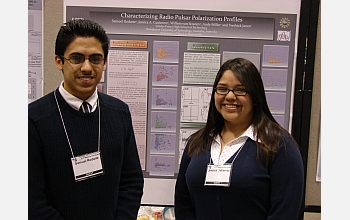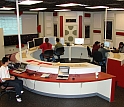News Release 08-015
Texas High School Students Present Research Results at National Astronomy Conference

High School students taking part in the Arecibo Remote Command Center Program.
January 30, 2008
This material is available primarily for archival purposes. Telephone numbers or other contact information may be out of date; please see current contact information at media contacts.
A team of high school students recently presented their research at the 211th meeting of the American Astronomical Society--the largest professional meeting of astronomers in North America. Trained at the Arecibo Remote Command Center, or ARCC, located on the campus of the University of Texas at Brownsville and Texas Southmost College, the students' results are contributing to a global scientific effort to develop a galactic scale gravitational wave observatory.
ARCC, funded by the National Science Foundation (NSF), is a program designed to involve students in astronomical research early in their careers. From this command center, students have the ability to control, in real time, the world's largest radio telescope, which is located in Arecibo, Puerto Rico. These high school students, along with undergraduate and graduate students, use Arecibo to search the galaxy for an exotic class of star known as a radio pulsar.
The students are directly involved in the observations and the follow-up data analysis. After collecting data using the newly installed Arecibo L-band Feed Array receivers, students enthusiastically search the results for evidence of periodic signals--the primary signature of a radio pulsar. To date, the students have evaluated more than 18,000 pulsar candidates.
"This project is proving itself to be quite effective in engaging students of many levels in the entire scientific process," said Fredrick A. Jenet, professor of physics and astronomy at the University of Texas in Brownsville, and a recent recipient of a NSF Career Award. A major component of this award has been to develop the ARCC program.
"My most rewarding experience as an educator has been to see our students presenting their science alongside professional astronomers here at the AAS," said Porter High School teacher Andy Miller. Miller recruits talented high school students from the Rio Grande Valley Region into the ARCC program and leads various training programs that introduce the students to astronomical research. Miller's first contact with students doing research came during an NSF-sponsored program of the National Optical Astronomy Observatory called Research Based Science Education (RBSE). "My belief is that high school students can do real research in astronomy and many of my contributions to the ARCC program were inspired by my participation in RBSE," Miller said.
"We can see evidence that the ARCC creates and maintains interest among students in science and astronomy," said Adrienne Zermeno, a doctoral student in physics who is evaluating the ARCC program and its ability to attract and retain Hispanics into science careers.
"Working with some of the greatest scientists and now presenting to others who are interested in what I have to say has been an exhilarating experience," said Anthony Ford, one of the four ARCC high school students presenting posters in the "Pulsars, Neutron Stars" session of the AAS meeting. Ford, together with high school student Irina Azcona and graduate student Kevin Stovall, presented the current results of the ARCC pulsar search effort.
"Viewing posters and attending presentations gave me the opportunity to learn more about our universe from some of the top minds in astronomy," said Jessica Gutierrez. High school students Samuel Rodarte and Gutierrez presented a new technique for characterizing radio pulsar polarization profiles.
Jenet, Miller and Zermeno have been developing the ARCC program for the past three years. In this time, nearly 50 students from the South Texas region have participated in the project.
The ARCC program has been recognized as a proven model to attract and train future scientists. The model is currently being replicated at the University of Wisconsin, Milwaukee and the University of Utah. Plans are being developed to export ARCC to other universities. The Commonwealth Scientific and Industrial Research Organization in Australia is also developing a sister program called PULSE@Parkes, modeled after the ARCC project using the Parkes radio telescope.
-NSF-
-
The Arecibo Remote Command Center.
Credit and Larger Version
Media Contacts
Diane Banegas, National Science Foundation, (703) 292-4489, email: dbanegas@nsf.gov
Letty Fernandez, University of Texas at Brownsville and Texas Southmost College, (956) 882-6535, email: leticia.fernandez@utb.edu
Program Contacts
Brian Patten, National Science Foundation, (703) 292-4910, email: bpatten@nsf.gov
Principal Investigators
Fredrick Jenet, University of Texas at Brownsville, (956) 882-5131, email: merlyn@phys.utb.edu
Related Websites
University of Texas and Texas Southmost College news release.: http://arcc.phys.utb.edu/news/AAS2008/
The U.S. National Science Foundation propels the nation forward by advancing fundamental research in all fields of science and engineering. NSF supports research and people by providing facilities, instruments and funding to support their ingenuity and sustain the U.S. as a global leader in research and innovation. With a fiscal year 2023 budget of $9.5 billion, NSF funds reach all 50 states through grants to nearly 2,000 colleges, universities and institutions. Each year, NSF receives more than 40,000 competitive proposals and makes about 11,000 new awards. Those awards include support for cooperative research with industry, Arctic and Antarctic research and operations, and U.S. participation in international scientific efforts.
Connect with us online
NSF website: nsf.gov
NSF News: nsf.gov/news
For News Media: nsf.gov/news/newsroom
Statistics: nsf.gov/statistics/
Awards database: nsf.gov/awardsearch/
Follow us on social
Twitter: twitter.com/NSF
Facebook: facebook.com/US.NSF
Instagram: instagram.com/nsfgov



